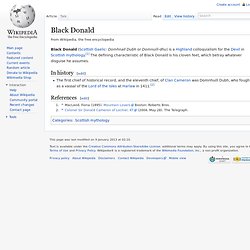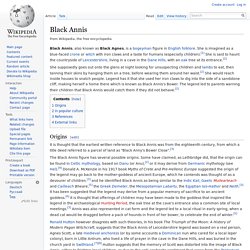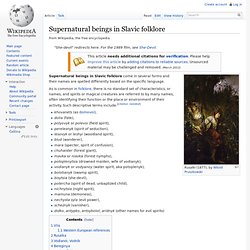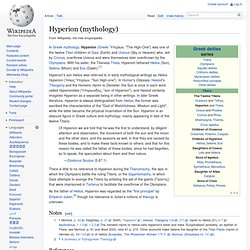

Black Donald. Black Donald (Scottish Gaelic: Domhnall Dubh or Domnuill-dhu) is a Highland colloquialism for the Devil in Scottish mythology.[1] The defining characteristic of Black Donald is his cloven feet, which betray whatever disguise he assumes.

In history[edit] The first chief of historical record, and the eleventh chief, of Clan Cameron was Domnhuill Dubh, who fought as a vassal of the Lord of the Isles at Harlaw in 1411.[2] References[edit] Black Annis. Black Annis, also known as Black Agnes, is a bogeyman figure in English folklore.

She is imagined as a blue-faced crone or witch with iron claws and a taste for humans (especially children).[1] She is said to haunt the countryside of Leicestershire, living in a cave in the Dane Hills, with an oak tree at its entrance.[2] She supposedly goes out onto the glens at night looking for unsuspecting children and lambs to eat, then tanning their skins by hanging them on a tree, before wearing them around her waist.[2] She would reach inside houses to snatch people. Legend has it that she used her iron claws to dig into the side of a sandstone cliff, making herself a home there which is known as Black Annis's Bower. The legend led to parents warning their children that Black Annis would catch them if they did not behave.[2] Origins[edit] In popular culture[edit] A boogeyman creature, quite similar to Black Annis, is mentioned in the stealth-action game "Thief: Deadly Shadows".
References[edit]
Pirates. Supernatural beings in Slavic folklore. Supernatural beings in Slavic folklore come in several forms and their names are spelled differently based on the specific language.

As is common in folklore, there is no standard set of characteristics, or names, and spirits or magical creatures are referred to by many names, often identifying their function or the place or environment of their activity. Such descriptive terms include:[citation needed] Vila[edit] The Vila are the Slavic versions of nymphs, who have power over wind, which they delight in causing storms of high winds. They live around hills, mountains, and high mounds. In Polish mythology, the Wiła (pronounced [ˈviwa]), and in South-Slavic mythology the Vila (Serbian pronunciation: [ʋǐːla]), are believed to be female fairy-like spirits who live in the wilderness and sometimes in the clouds. It is said that if even one of their hairs is plucked, the Vila will die, or be forced to change back to her true shape. Far Darrig (Red Man)
The far darrig (or fear dearg) is a near relation to the leprechaun, with similar features and a short stocky body.

His face is splotched yellow. He dresses in red from his hat to his tail-trailing cape to the woolen stockings which cling to his calves. This is the reason he is called the far darrig or red man. He is known not only for his color (sometimes he travels invisibly) but for his delight in mischief and mockery. He can be a gruesome practical joker. Hyperion (mythology) Hyperion's son Helios was referred to in early mythological writings as Helios Hyperion (Ἥλιος Ὑπερίων, "Sun High-one").

In Homer's Odyssey, Hesiod's Theogony and the Homeric Hymn to Demeter, the Sun is once in each work called Hyperionides (Ὑπεριωνίδης, "son of Hyperion"), and Hesiod certainly imagines Hyperion as a separate being in other writings. In later Greek literature, Hyperion is always distinguished from Helios; the former was ascribed the characteristics of the "God of Watchfulness, Wisdom and Light", while the latter became the physical incarnation of the Sun. Hyperion is an obscure figure in Greek culture and mythology, mainly appearing in lists of the twelve Titans: As the father of Helios, Hyperion was regarded as the "first principle" by Emperor Julian,[2] though his relevance in Julian's notions of theurgy is unknown.
Theoi Project - Hyperion.
Clans.